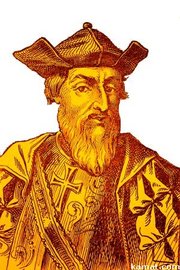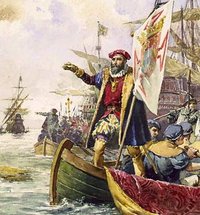Vasco da Gama
|
|
Vasco da Gama (c. 1469–December 24, 1524) was a Portuguese explorer who was the first person to sail directly from Europe to India.
Life
From the early 15th century, the nautical school of Henry the Navigator had been extending Portuguese knowledge of the coast of Africa. From the 1460s, the goal had become one of rounding that continent's southern extremity and gaining easier access to the riches of India (mainly black pepper and other spices) through a reliable sea route instead of the costly and unsafe overland route.
Da Gama was born in Sines. He was slightly younger than 20 years old as these long-term plans were coming to fruition. Bartolomeu Dias had returned from rounding the Cape of Good Hope and exploring as far as the Fish River in modern-day South Africa, while Pero da Covilhã in India had explored south for some of the distance intervening between subcontinent and the end of explorations. It remained only for the two segments to be joined into one voyage.
This task was given to Da Gama's father, Estêvão da Gama, but he died before he could begin. Vasco was then given the job on the strength of his work for the Portuguese crown along the Gold Coast of Africa. On July 8, 1497 four ships (the São Gabriel, the São Rafael, whose commander was his brother Paulo da Gama, the Berrio, and a storage ship of unknown name) left Lisbon and the voyage began.
By December 16 they had passed the Fish River and continued on into waters unknown to Europeans. With Christmas pending they gave the coast they were passing the name Natal (Christmas in Portuguese), which it retains to this day. By January they had reached modern-day Mozambique, Arab-controlled territory on the East African coast that was part of the Indian Ocean's network of trade. Having got that far, da Gama was able to employ a pilot at Malindi, who brought the expedition the rest of the way to Calicut (the exact Malayalam name is Kozhikode) on the southwest coast of India on May 20, 1498. Sometimes violent negotiations with the local ruler (the Samoothiri Raja, usually anglicized as Zamorin) ensued in the teeth of resistance from Arab merchants. Eventually da Gama was able to gain an ambiguous letter of concession for trading rights, but had to sail off without warning after the Zamorin insisted on his leaving behind all his goods as collateral. Da Gama kept his goods, but left behind a few Portuguese with orders to start a trading post.
Upon his return to Portugal in September 1499, da Gama was richly rewarded as the man who had brought to fruition a plan that had taken eighty years. He was given the title "Admiral of the Indian Ocean", and on February 12, 1502 he sailed again with a fleet of twenty warships to enforce Portuguese interests. Pedro Álvares Cabral had been sent out two years earlier (on which voyage he incidentally discovered Brazil) and found that those at the trading post had been murdered, encountered further resistance and bombarded Calicut.
Da Gama assaulted and exacted tribute from the East African Arabian port of Kilwa, which had been one of those involved with frustrating the Portuguese; he played privateer amongst Arab merchant ships; and then finally smashed a Calicut fleet of twenty-nine ships and essentially conquered that port city. In return for peace, he received valuable trade concessions and a vast quantity of plunder that put him in extremely good favor with the Portuguese crown. Returning to Portugal, he was made Count Vidigueira out of lands that had previously belonged to the royal Bragança family.
Having acquired a fearsome reputation as a "fixer" of problems that arose in India, he was sent to the subcontinent once more in 1524. The intention was that he was to replace the incompetent Eduardo de Menezes as viceroy of the Portuguese possessions, but he died not long after arriving in Calicut. After burial for some time at St.Francis Church, Fort Kochi, Kochi, India, his remains were returned to Portugal in 1539 and re-interred in Vidigueira.
As much as anyone after Henry the Navigator, da Gama was responsible for Portugal's success as an early colonizing power. Besides the first voyage itself, it was his astute mix of politics and war on the other side of the world that placed Portugal in a prominent position in the Indian Ocean trade. The Portuguese "national epic", the Lusíadas of Luís Vaz de Camões largely concerns Vasco da Gama's voyages.
Reference
- Kelly, Jack (2004). Gunpowder: Alchemy, Bombards, & Pyrotechnics. ISBN 0465037186 - The history of the explosive that changed the world from Vasco da Gama to E.I. DuPont.
See also
- the football (soccer) club: Clube de Regatas Vasco da Gama
Template:Commonsbn:ভাস্কো ডা গামা
ca:Vasco da Gama
cs:Vasco da Gama
cy:Vasco da Gama
da:Vasco da Gama
de:Vasco da Gama
es:Vasco da Gama
eo:Vasco da GAMA
fr:Vasco de Gama
ga:Vasco da Gama
hr:Vasco da Gama
id:Vasco da Gama
it:Vasco da Gama
he:ואסקו דה גאמה
ms:Vasco da Gama
nl:Vasco da Gama
ja:ヴァスコ・ダ・ガマ
no:Vasco da Gama
pl:Vasco da Gama
pt:Vasco da Gama
ro:Vasco da Gama
ru:Васко да Гама
simple:Vasco da Gama
sk:Vasco da Gama
sl:Vasco da Gama
sr:Васко де Гама
fi:Vasco da Gama
sv:Vasco da Gama
uk:Васко да Ґама
zh:瓦斯科·達·伽馬


